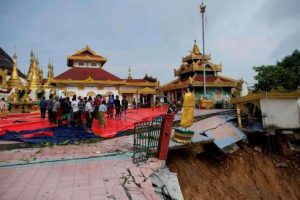In Storehouse of Treasures: Recovering the Riches of Chan and Zen (Shambala, 2024), author and lay Zen teacher Nelson Foster has published a book about the “treasures” of Chan and Zen Buddhism. The essays within this collection embody what could be called “Zen Americana”—a seamless integration of inherited ancient teachings into his modern cultural being, or context, as an American. Foster names Robert Aitken, Yamada Roshi, and other figures as being inheritors of a cross-cultural continuity. But the modern, Western-influenced expressions of Chan and Zen form only one side of the story. One of Foster’s major themes is his presentation of Chan and Zen, as well as the Western assimilation of those traditions, as part of a shared spiritual project dating back hundreds of years.
After an extended and fascinating initial discussion about the meaning of bao (Ch: 寶) and zang (Ch: 藏), Foster notes that “the treasures in question are, without a doubt, elements of a common heritage.” (viii) For him, this common heritage or cultural nexus must be treasured (pun not intended). It required “a lot of painstaking work” for any of Chan and Zen’s “historical and traditional richness to come to the West. So much of the culture becomes involved in ways that we don’t realize.” (xv)
Foster is hopeful that his collection of essays will reflect a certain reverence of what the dhyana tradition has historically prized: spontaneity, naturalness, non-artifice. The essays cover a range of subjects that Foster encountered over his time learning from masters in the West, and becoming a teacher himself. It starts off in a relatively conventional manner, and the preface does not initially seem to give away much more. In his first essay, “Getting to the Spring—and Beyond,” Foster discusses, with reference to Yamada Roshi, the experience of translating one of the poems of the High Tang wordsmith Wang Wei as a process of understanding not just the activity of translating, but also Wang Wei’s “exquisitely beautiful vision of the world,” “disencumbered of selfhood.” (6)
But the scope and ambition of the essays quickly grow at a pace and with a force that would impress any well-read Buddhist. Foster’s articles are not simply eloquent and vivid, which could simply indicate that he describes a situation well. Rather, he threads together complicated subjects stretched far apart in temporal and spatial terms, crunching events and people in time and space into an effortless piece of writing that resembles an offering from a Buddhist G. K. Chesterton, F. Scott Fitzgerald, or any other master essayist that may come to mind.
One of the reasons why I think he manages to reach this level is his fearlessness in deploying his essayist skills to take on the big subjects, bigger than religions, bigger than politics: we are talking about the vast existential conditions that make us human. Friendship, confronting scandals and wrongdoing, ecology—no stone is left unturned in the garden of Zen.
In another example, the essay “Putting Integrity Back into Integrity” is a masterclass in exploring the idea of being true to oneself, the different sides of authenticity, and possibly what Sartre called living in bad faith. In other words, what is foundational to Chan ideas of integrity is cheng or makoto (Ch: 誠), which has evolved throughout East Asian Buddhism as a “naked heartmind,” a wondrous and “absolute transparency in thought and feeling” that, if accomplished even once, “can discharge one’s obligation to society and bring peace to the whole nation.” (59)
An astute observer of not only the human condition but also worldly affairs, Foster does not avoid observations from the political sphere (which in the case of the Clinton versus Trump presidential race in 2016, is already ancient history). In many of his essays, he invokes historical examples and people, from Daoist philosophers to the American Civil War. He does the Buddhist tradition an additional favor with his body of writing. Perhaps intentionally, perhaps not, Foster reveals that Buddhism indeed has the intellectual, textual, and cultural resources to address the big things that make us human (although they are undoubtedly coming from a different philosophical or theological origin than those of the West).

Aside from the piece on integrity, Foster’s essay on shame is a clear demonstration of this, in which he brings together Confucian, Chan, and Zen writings to argue how shame, as a child, is felt as a burning agony, suffocating and bewildering. But with age, maturity (hopefully), and most definitely practice, shame becomes a blessing rather than a burden, (74) an invigorating splash of cold water on the face that reminds us that we can do better. Socrates was ashamed of how little he knew, precisely because he was so wise.
Another of Foster’s characteristic styles is unpacking Chinese words that have a storied meaning in the Chan and Zen literary canon. The above essays all do this, but because Chinese characters express meaning visually and structurally, rather than forming the words to express a meaningful concept, as Indo-European words and syllables do. Foster leaves a few of his most ambitious essays for last, such as a sweeping contemplation of ziran, or nature, in “How the World Works,” analyzing the notion and deep reality of chaos in “Hundun the Beneficent, or Chaos Reconsidered,” and finally, considering the apparently paradoxical act of no-action and resting in perfect equanimity, and what Buddhists would recognize as bodhicitta: the passion to liberate all beings in “Wuwei and the Power to Desist.”
As the titles of the essays indicate (to provide a proper commentary on them would require essays of my own), no matter which essay the individual reader finds the most insightful, the blend of Daoist, Confucian, and Western inherited wisdom and history combine with the unique literature of Chan and Zen to make for some truly delightful reading.
Although Foster might be revealing treasures, the overt theme actually recedes into the background the more one reads. Running more prominently through all these essays is a powerful and compelling sensitivity to translation in all its facets and layers. One example that is pertinent to the Zen tradition is Jingshan Temple in Zhejiang Province, a Chan temple that transmitted the art of the tea ceremony to Japan, ensuring tea’s vital role in Japanese Zen. Translation is much more than rendering Sanskrit into Chinese into Japanese and finally into English. It is art, food and drink, culture, and technology. It goes beyond even cultural dialogue between the intersecting past and present civilizations of East and West. It is about the dialectic between the philosophical traditions of Daoism, Confucianism, Chan, and Zen. It is about bridging ancient history and the scriptures’ inheritance with our day-to-day application. It is about seeing entire worlds embodied in characters and expressions that are not actually that esoteric (and are indeed well-known to Chan and Zen Buddhists as well as people living in East Asia). And it is about understanding how the present moment, this very heartbeat, encompasses the entire cosmos in all its mind-boggling majesty and minuteness.
References
Nelson Foster. 2024. Storehouse of Treasures: Recovering the Riches of Chan and Zen. Boulder, CO: Shambhala Publications.
Related news reports from BDG
American Soto Zen Priest and Engaged Buddhist Hozan Alan Senauke Has Died, Aged 77
Related features from BDG
My Furry Zen Master
Book Review: The Intimate Way of Zen by James Ishmael Ford
Book Review: Hakuin’s Song of Zazen















